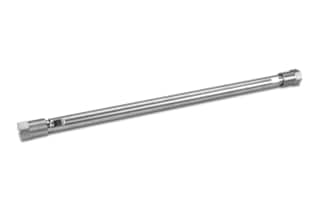
Primarily supports legacy methods. 10 µm diol-bonded gel filtration materials.
|
Chemistry |
SEC |
|
Separation Mode |
SEC/GPC |
|
Particle Substrate |
Silica |
|
pH Range Min |
2 pH |
|
pH Range Max |
8 pH |
|
Bonding Technology |
SEC |
|
Molecular Weight Range Min |
2000 |
|
Molecular Weight Range Max |
80000 |
|
Particle Shape |
Irregular |
|
Particle Size |
10 µm |
|
Endfitting Type |
Waters |
|
Pore Size |
125 Å |
|
Format |
Column |
|
System |
HPLC |
|
USP Classification |
L20 |
|
Inner Diameter |
7.8 mm |
|
Length |
300 mm |
|
UNSPSC |
41115709 |
|
Application |
Protein |
|
Brand |
Protein-Pak |
|
Product Type |
Columns |
|
Units per Package |
1 pk |

Protein-Pak 125 Column, 10 µm, 7.8 mm x 300 mm, 1/pk
With packings based on a 10 µm diol-bonded silica, Protein-Pak 125 Columns are made to resolve proteins that differ in molecular weight by a factor of two, as well as distinguishing proteins that differ by as little as 15% in molecular weight. This allows for the separation of biopolymers, including proteins and enzymes, in HPLC applications. The degree of resolution will be dependent on the sample mass and the volume more than the interaction between sample and stationary phase.
Protein-Pak 125 Columns are suited to the following weight ranges: Native Globular 2,000 – 80,000 and Random Coil 1,000 – 30,000. Columns are shipped in 100% methanol and contain one column per order. The inner diameter of these columns is 7.8 mm with a length of 300 mm.
In ideal scenarios, there will be no interaction between the stationary phase and the sample molecules. Because secondary interactions are most often ionic, they can usually be reduced by increasing the ionic strength of the mobile phase. Typical salt concentrations range from 0.2 – 0.5 M NaCl. It could also be useful in some cases to consider adding 10-20% methanol to eliminate hydrophobic and other hydrogen bonding interactions.
For decades, Waters has offered continuous improvements to SEC, with refined instrumentation, packing materials, and technologies. This allows for innovations that expand size-exclusion techniques beyond the original polymer analysis. Like all Waters lab equipment, Protein-Pak 125 Columns are thoroughly tested in a quality-controlled laboratory to ensure adherence to stringent specifications. These products work well in conjunction with the Protein-Pak SP 5PW Glass, 8 mm x 75 mm, 1/pk, among other Waters’ products.
What Solvents And Buffers Should Be Used With Protein-Pak 125 Columns?
Protein-Pak 125 Columns are shipped containing an organic solvent that is compatible with water-miscible solvents, such as methanol and acetonitrile. If an immiscible solvent is to be used for analysis, the changeover should be made gradually using at least one intermediate solvent. This is similar to changing over solvents during analysis. When changing the organic concentration in the mobile phase to reduce the flow rate. When adding organic solvents to aqueous buffer solutions avoid salt precipitation. Protein-Pak Columns are stable in normal salt buffer solutions like sodium sulfate, ammonium acetate, ammonium formate, phosphate buffers, tris acetate, and acetate buffers. Generally, the salt concentrations in aqueous solutions should be maintained below 0.5 M.